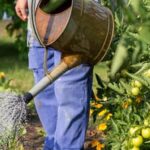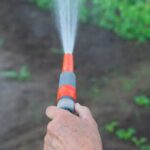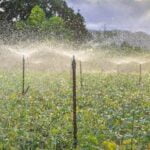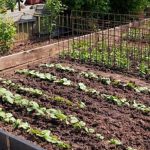Winter container vegetable gardening is a wonderful way to continue growing fresh produce even during the cold winter months. While traditional gardening may seem impossible in freezing temperatures, container gardening provides a practical solution for those who want to nurture their green thumbs all year round. By bringing the garden indoors and utilizing containers, it is possible to grow a variety of vegetables in small spaces and reap the rewards of homegrown goodness even when snow covers the ground.
In this article, we will explore the concept of winter container vegetable gardening and how it allows gardeners to extend their growing season. We will discuss the benefits of engaging in this practice, such as having access to freshly grown and nutritious vegetables throughout the winter.
Additionally, we will guide you through choosing the right containers for your plants, selecting cold-tolerant vegetable varieties, preparing the soil and planting properly, watering and maintenance tips during winter months, protecting against frost and freezing temperatures, harvesting techniques, extending the growing season, troubleshooting common challenges faced during winter gardening.
Whether you are an experienced gardener or a beginner with limited outdoor space, winter container vegetable gardening can provide immense satisfaction and endless possibilities. With just a few containers by your window sill or on your balcony or patio, you can enjoy all the joys of tending to plants while providing yourself with nourishing food during wintertime. So come along as we embark on this journey of exploring the art and science behind successful winter container vegetable gardening.
Benefits of winter container vegetable gardening
Winter container vegetable gardening offers several benefits that make it an attractive option for gardeners.
One of the key advantages is that it allows individuals to continue growing their own fresh vegetables even in colder climates or when outdoor gardening space is limited. By utilizing containers, gardeners can have a portable garden that can be placed anywhere with access to sunlight, such as a balcony, patio, or even indoors near a sunny window. This flexibility opens up possibilities for urban dwellers, apartment residents, or anyone with limited outdoor space to grow their own food.
Another benefit of winter container vegetable gardening is the ability to extend the growing season. By planting cold-tolerant varieties and providing protection against frost and freezing temperatures, gardeners can continue harvesting fresh produce well into the winter months. This not only provides a source of nutritious food but also allows individuals to save money by reducing trips to the grocery store.
Additionally, container gardening during winter offers greater control over the growing environment. Containers allow gardeners to manipulate soil conditions, sun exposure, and temperature more easily compared to traditional in-ground gardens. This control minimizes the risk of certain pests and diseases that are more common in outdoor gardens during the winter season.
Overall, the benefits of winter container vegetable gardening make it an attractive option for individuals looking to enjoy fresh produce year-round, maximize limited space, and have greater control over their growing environment. With some planning and preparation, anyone can experience the joys of successful winter container vegetable gardening.
Choosing the right containers
Choosing the right containers for winter vegetable gardening is crucial for the success of your plants. Different types of containers and materials can affect the growth and wellbeing of your vegetables. Here are some options to consider:
- Terracotta pots: These clay pots offer good insulation and drainage, making them suitable for winter gardening. However, they are prone to cracking in freezing temperatures, so it’s important to protect them from extreme cold.
- Plastic containers: Plastic pots are lightweight and budget-friendly options for winter gardening. They provide insulation and retain moisture well. Look for containers with UV protection to prevent them from becoming brittle in sunlight.
- Fabric pots: Fabric containers are becoming increasingly popular due to their excellent drainage capabilities. They allow air circulation to the plant roots, promoting healthier growth. These are also collapsible and easy to store during the offseason.
- Raised beds: If you have enough space, consider using raised beds for winter gardening. This option provides more soil volume, insulation, and better temperature control compared to individual containers.
When choosing containers, ensure that they have proper drainage holes at the bottom to prevent waterlogging, which can lead to root rot. Additionally, consider the size of the container based on the mature size of your chosen vegetables.
| Type of Container | Advantages |
|---|---|
| Terracotta pots | Good insulation and drainage |
| Plastic containers | Lightweight and budget-friendly; retains moisture well |
| Fabric pots | Excellent drainage; promotes airflow around roots |
| Raised beds | More soil volume; better temperature control |
In addition to the type of container, consider the material’s insulation properties. For example, terracotta and plastic containers retain heat better than metal containers. However, you can compensate for metal containers’ poor insulation by wrapping them with insulating materials like bubble wrap or burlap.
Remember that the size of your container will determine how many vegetables you can grow. Larger containers allow for more space for root development and water retention.
Ultimately, choosing the right container for your winter vegetable gardening depends on factors such as available space, budget, and personal preference. Consider these options and select the containers that best suit your needs and the needs of your chosen vegetables.
Selecting the best cold-tolerant vegetable varieties
When it comes to winter container vegetable gardening, selecting the right cold-tolerant vegetable varieties is crucial. Not all vegetables can withstand the harsh conditions of winter, so choosing varieties that thrive in cold temperatures is essential for a successful garden.
Leafy Greens and Brassicas
Leafy greens such as kale, spinach, and Swiss chard are well-known for their cold tolerance. These hearty vegetables can survive temperature drops and continue to produce throughout the winter. Brassicas like broccoli, Brussels sprouts, and cabbage are also excellent choices for winter container gardening. They not only tolerate the cold but even improve in flavor after exposure to frost.
Root Vegetables
Root vegetables are another group that performs well in colder weather. Carrots, beets, and turnips can handle freezing temperatures as long as they are adequately insulated in the containers. They provide a delicious addition to winter dishes and can be harvested throughout the season.
Herbs
Although herbs typically prefer warmer conditions, some varieties can still thrive during winter and add flavor to your meals. Herbs like parsley, cilantro, rosemary, and thyme have good cold tolerance and can be grown in containers with proper care.
Peas
Peas are an excellent option for winter container gardening because they prefer cooler temperatures. There are various pea varieties specially bred for overwintering that can withstand frost without any issues. Snow peas and snap peas are particularly popular choices for growing in containers during the winter months.
By selecting these cold-tolerant vegetable varieties, you can ensure a bountiful harvest even during chilly winters. It is essential to research which specific cultivars perform best in your local climate to maximize your chances of success. You may also consider experimenting with different varieties each year to discover new favorites that thrive in your unique growing conditions.
Preparing the soil and planting
Preparing the soil is an essential step in setting up a successful winter container vegetable garden. The first thing to consider is the type of soil you will use for your containers. It is recommended to use a high-quality potting mix that is well-draining and nutrient-rich. This will provide the necessary support and nutrients for your plants to grow.
Before planting, it’s important to ensure that your containers have proper drainage holes to prevent waterlogging. If your containers don’t have drainage holes, you can drill them yourself or place a layer of small rocks or pebbles at the bottom of the container to improve drainage.
Once you have prepared your containers, it’s time to fill them with the potting mix. Fill each container about ¾ full, leaving enough space at the top for watering. You can also add some organic matter, such as compost or well-rotted manure, to enrich the soil further.
After filling the containers with potting mix, it’s time to plant your vegetables. Start by selecting cold-tolerant vegetable varieties that are suitable for winter gardening. Some popular choices include kale, spinach, lettuce, Swiss chard, and carrots. Follow the instructions on the seed packet or plant label regarding spacing and planting depth for each vegetable.
When planting seeds, make sure to sow them at the appropriate depth and cover them lightly with soil. For transplants, gently remove them from their nursery pots and place them in the container at their recommended spacing. Firmly press down on the soil around each plant or seedling to ensure good contact between roots and soil.
| Step | Description |
|---|---|
| 1 | Prepare containers with proper drainage holes. |
| 2 | Fill containers with well-draining and nutrient-rich potting mix, leaving space for watering. |
| 3 | Add organic matter, such as compost or well-rotted manure, to enrich the soil. |
| 4 | Select cold-tolerant vegetable varieties suitable for winter gardening. |
| 5 | Sow seeds at the appropriate depth or transplant seedlings according to spacing guidelines. |
| 6 | Firmly press down on the soil around each plant or seedling for good root-soil contact. |
Remember to label your containers with the name and variety of each vegetable to keep track of your plants. Additionally, it’s crucial to provide proper sunlight and temperature conditions for your container garden. Place the containers in a sunny spot that receives at least six hours of direct sunlight daily, and monitor the temperature to ensure it stays within the ideal range for your chosen vegetables.
By following these steps and providing the right conditions, you will give your winter container vegetables a strong start and set them up for successful growth throughout the winter season.
Watering and maintenance
During the winter months, proper watering and maintenance are crucial for the health and success of your container vegetables. While it may seem counterintuitive to water plants in cold weather, it is essential to provide them with adequate moisture to ensure they thrive. Here are some tips on how to properly water and maintain your container vegetables during the winter:
- Monitor soil moisture: Check the moisture level of the soil regularly using a moisture meter or by feeling the top inch of soil with your finger. Watering frequency will depend on factors such as temperature, humidity, and container size. Generally, you should aim to keep the soil evenly moist but not waterlogged.
- Avoid overwatering: Overwatering can lead to root rot and other fungal diseases. Make sure that excess water can freely drain out of the containers by ensuring they have drainage holes at the bottom. If there is pooling water on top of the soil after watering, reduce the amount of water you apply in future watering sessions.
- Water deeply: Instead of giving your plants a light sprinkle, water deeply until you see water draining out from the bottom of the containers. This helps ensure that water reaches all parts of the root system.
In addition to proper watering, there are other maintenance tasks that need attention during winter container vegetable gardening:
- Fertilize sparingly: During winter, plants go through slower growth rates and their nutrient requirements decrease. Avoid over-fertilizing as it can promote excessive foliage growth at a time when sunlight is limited. Use a balanced slow-release fertilizer or organic compost to provide necessary nutrients in small quantities.
- Remove debris: Regularly inspect your containers for fallen leaves, dead plant material, pests, and weeds. Remove any debris promptly as it can harbor diseases and pests.
- Monitor for pests and diseases: Inspect your plants for any signs of pest infestation or disease. Use organic methods, such as insecticidal soaps or neem oil, to control pests if necessary. If you notice any signs of disease, promptly remove affected plant parts to prevent the spread.
Taking care of your container vegetables during the winter months will ensure healthy growth and a bountiful harvest. By monitoring soil moisture levels, avoiding overwatering, and performing regular maintenance tasks, you can set yourself up for a successful winter container vegetable garden.
Protecting against frost and freezing temperatures
When it comes to winter container vegetable gardening, one of the main challenges is protecting your plants from frost and freezing temperatures. The key to successfully safeguarding your container plants lies in implementing effective strategies that will shield them from the harsh winter conditions. Here are some tried-and-true methods to help you protect your container vegetables:
- Choose the right location: Before planting your containers, carefully consider where they will be placed. Opt for a location that provides some form of protection, such as against a south-facing wall or under an overhang. This will help to create a microclimate that can minimize exposure to frost and cold winds.
- Utilize insulation: Insulating your containers can go a long way in preventing frost damage. Surrounding your pots with insulating materials like straw, bubble wrap, or straw bales can provide an extra layer of protection against freezing temperatures. Additionally, placing burlap or frost blankets around your containers can offer added insulation by trapping warm air.
- Implement heating methods: In extremely cold climates, using heating devices may be necessary to protect your container plants. Options like heat lamps or electric soil warming cables can help maintain the temperature within an acceptable range for vegetable growth. However, it is crucial to follow safety guidelines when using such equipment and ensure proper ventilation to prevent fire hazards.
- Apply mulch: Mulching is another effective approach to retain moisture, prevent soil erosion, and insulate roots from freezing temperatures in container gardens during winter months. Consider adding a layer of organic mulch like straw or leaves on top of the soil surface to aid in temperature regulation and provide additional protection.
By following these strategies for protecting against frost and freezing temperatures, you can ensure the health and survival of your container vegetables throughout the winter season. With careful planning and proactive measures in place, you’ll be able to cultivate a thriving winter garden and enjoy the fresh taste of homegrown vegetables even in the coldest months.
Harvesting and extending the growing season
Harvesting and extending the growing season are important aspects of winter container vegetable gardening. One of the benefits of growing vegetables in containers during winter is the ability to have fresh produce even when it’s cold outside. The key is to know when and how to harvest your crops.
When it comes to harvesting vegetables during winter, timing is crucial. You want to harvest your crops before they freeze, but also at a stage where they are mature and flavorful. It’s important to monitor the growth of your plants closely and keep an eye on weather forecasts. Harvesting during the warmest part of the day can help ensure that your vegetables are at their best quality.
To extend the winter growing season, there are a few techniques you can use. One popular method is using row covers or cloches to protect your plants from frost and provide some insulation against the cold temperatures. These coverings can be made from materials such as plastic or fabric, and should be removed during warmer days to allow for sunlight and airflow.
Another technique is called succession planting, which involves staggering your plantings so that you have a continuous supply of fresh produce throughout the winter months. This can be done by starting new seeds indoors and transplanting them into containers as others are harvested. By planning ahead and sowing seeds at appropriate intervals, you can ensure a steady harvest throughout winter.
Additionally, utilizing cold frames or mini greenhouses can greatly extend the growing season for container vegetables. These structures provide extra protection against extreme cold temperatures while still allowing sunlight in. They create a microclimate that mimics a warmer environment, enabling you to grow vegetables longer than would be possible without them.
Troubleshooting common winter gardening challenges
Winter container vegetable gardening comes with its own set of challenges. However, with proper troubleshooting and problem-solving techniques, these challenges can be overcome for a successful winter gardening experience.
One common challenge in winter gardening is the lack of sunlight. As the days are shorter and the sun is at a lower angle, it may be difficult for plants to get adequate sunlight. To address this issue, it is important to choose a suitable location for your containers that receives maximum sunlight during the day.
Consider placing them by a south-facing wall or near a window that gets good exposure to the sun. Additionally, using reflective materials such as aluminum foil or white paint on nearby walls can help in increasing the amount of light reaching your plants.
Another challenge faced in winter container vegetable gardening is temperature control. Freezing temperatures can harm or even kill your plants if not properly protected. One effective solution is to insulate your containers by wrapping them with bubble wrap or burlap cloth. This will help to retain some heat and prevent rapid temperature fluctuations. It is also recommended to avoid watering late in the day as wet soil can freeze more easily overnight.
Pests and diseases are not limited to just warm weather seasons; they can still pose a threat in winter gardening as well. Some common pests during winters include aphids, mealybugs, and slugs. Regularly inspecting your plants for any signs of pest infestation and taking immediate action such as using organic insecticides or removing affected plants can prevent further damage.
Moreover, diseases like root rot or fungal infections can occur due to excessive moisture caused by overwatering during winters. Ensure that you maintain proper watering practices and allow enough time for the soil to dry out between waterings.
By addressing these common challenges through innovative solutions and careful attention, successful winter container vegetable gardening can be achieved, resulting in nutritious homegrown vegetables throughout the chilly season.
Conclusion
In conclusion, winter container vegetable gardening offers numerous benefits and joys for both experienced gardeners and beginners alike. By growing vegetables in containers during the winter season, you can enjoy fresh produce all year round, even in colder climates. The ability to control the growing environment ensures proper growth and development of vegetables, resulting in high-quality harvests.
One of the main advantages of winter container vegetable gardening is the flexibility it provides. Containers can be placed anywhere, whether it’s a balcony, patio, or even indoors near a sunny window. This makes gardening accessible to those with limited space or without access to a traditional garden plot. Additionally, containers can be easily moved to take advantage of optimal sunlight or protected from extreme weather conditions.
Choosing the right containers is crucial for successful winter gardening. Consider materials such as plastic or fiberglass that provide insulation and prevent freezing of roots. Raised beds and large pots offer more soil volume, which helps maintain consistent temperatures and moisture levels. By selecting cold-tolerant vegetable varieties and properly preparing the soil, you can ensure healthy growth throughout the winter months.
To ensure thriving plants during winter container vegetable gardening, proper watering and maintenance are essential. Water consistently but avoid over-watering to prevent waterlogged roots that may freeze and cause damage. Regularly monitor soil moisture levels to ensure plants receive adequate hydration. Additionally, protect against frost by covering containers with blankets or moving them indoors during extreme temperatures.
Frequently Asked Questions
What vegetables can you grow in pots in the winter?
There are several vegetables that can be successfully grown in pots during the winter season. One popular option is leafy greens like spinach, lettuce, and kale. These vegetables thrive in cooler temperatures and can provide a fresh addition to your meals throughout the winter months.
Another option is root vegetables such as radishes and carrots, which can be grown in deeper pots to accommodate their growth. Additionally, certain herbs like parsley and cilantro can also be easily grown in pots during the winter, adding flavor to your dishes all year round.
What to do with vegetable pots in winter?
Taking care of vegetable pots during the winter is essential for maintaining healthy plants. One important step is to protect the pots from extreme cold by insulating them with materials like bubble wrap or hessian sacks. This will help prevent the roots from freezing and damaging the plant.
It’s also crucial to provide proper drainage for the pots to avoid waterlogging, as excess moisture can cause root rot. Positioning the pots in a location that receives adequate sunlight exposure is necessary for supporting growth during the limited daylight hours of winter. Regularly checking on the moisture levels of the soil and watering only when necessary will help ensure that your vegetable plants survive through the winter season.
What are the top 5 common veggies that can be planted during winter?
The top five common vegetables that can be planted during winter are cabbage, broccoli, Brussels sprouts, cauliflower, and onions. Cabbage is a hardy vegetable that thrives in cooler temperatures and can withstand some frost, making it an excellent choice for winter planting. Broccoli also performs well in colder climates and produces delicious heads during this time of year. Brussels sprouts are known for their ability to tolerate frost and usually taste even sweeter after being subjected to colder temperatures.
Cauliflower is another vegetable that adapts well to wintertime conditions and rewards gardeners with its white curds when planted during this season. Finally, onions are often planted in fall or early winter as they require a longer growing period but benefit from the cooler temperatures to develop their bulbs. These five vegetables are prime options for winter planting and can provide a fresh and healthy harvest.

If you’re looking to get into vegetable gardening, or are just looking for some tips on how to make your current garden better, then you’ve come to the right place! My name is Ethel and I have been gardening for years. In this blog, I’m going to share with you some of my best tips on how to create a successful vegetable garden.





